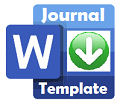Pengembangan Pembelajaran al-Qur’an Hadits Surah az-Zalzalah pada Media E-Learning Berbasis Edmodo
DOI:
https://doi.org/10.35309/alinsyiroh.v7i1.4367Keywords:
Keywords: Al-Qur'an Hadith, Media E-learning, EdmodoAbstract
Based on the criteria of learning al-Qur'an Hadith with the material of surah az-Zalzalah, it can be said that it is valid and effective for grade IV students of Madrasah Ibtidaiyah. To compile and produce learning, it is necessary to research the development of e-learning media through edmodo. Can increase the creativity of students in learning al-Qur'an Hadith about surah az-Zalzalah using e-learning media through edmodo. This type of research is the ADDIE model that has been used in the development of Al-Qur'an Hadith learning through edmodo e-learning media. There are 5 stages in the ADDIE model, namely analysis, design, development, application and evaluation. Has been validated by 3 lecturers as validator experts, media and instruments on e-learning media through edmodo. The subjects in development research were 30 grade students for the 2020-2021 school year. Learning al-Qur'an Hadith surah az-Zalzalah can be said to be good and meet the requirements with a rating of 78.34% through the edmodo e-learning media. However, students can respond to the learning media with a rating of 82.36% and have been declared good. Thus, all aspects of e-learning media through edmodo in learning al-Qur'an Hadith surah az-Zalzalah can be categorized as good and feasible to be used in the learning process.References
Batita, M. S. R., Wijoyo, S. H., Herlambang, A. D., & Maurish Sofie Rahmi Batita, Satrio Hadi Wijoyo, A. D. H. (2019). Analisis Perbandingan Blended Learning berbasis Edmodo dan Google Classroom ditinjau dari Motivasi dan Hasil Belajar Siswa. Jurnal Pengembangan Teknologi Informasi Dan Ilmu Komputer, 3(4), 3756–3764. http://j-ptiik.ub.ac.id
Belina, E. P., & Batubara, F. R. (2013). Perancangan dan Implementasi Aplikasi E-Learning versi Mobile Berbasis Android. IV, 76–81.
Di, P. C.-, & Nurulhuda, M. I. (2020). Imam Ja ’ far Shodiq dan Husniyatus Salamah Zainiyati 144. 6(2), 144–159.
Fandianta dkk. (2013). Meningkatkan Pengetahuan Mahasiswa Dengan Memberikan Fleksibilitas Belajar Melalui Metode Blended learning. Jurnal Pendidikan Kedokteran Indonesia, 2(2), 1–8.
Hamid, A., Setyosari, P., Kuswandi, D., & Ulfa, S. (2019). The implementation of mobile seamless learning strategy in mastering students’ concepts for elementary school. Journal for the Education of Gifted Young Scientists, 7(4), 967–982. https://doi.org/10.17478/jegys.622416
Hamzah, Amir. (2019). Metode Penelitian dan Pengembangan (Research and Development): Uji Produk Kuantitatif dan Kualitatif Proses dan Hasil. Malang: CV. Literasi Nusantara Abadi.
Hanum, N. S. (2013). Keefektifan E-Learning sebagai Media Pembelajaran: Studi Evaluasi Model Pembelajaran E-Learning SMK Telkom Sandhy Putra Purwokerto. Jurnal Pendidikan Vokasi, III No.1, 92.
Holland, C., & Muilenburg, L. (2011). Supporting Student Collaboration: Edmodo in the Classroom. In Society for Information Technology & Teacher Education International Conference, No. 1, 3232–3236.
Junaidi, J. (2018). Model Pendidikan Multikultural. Al-Insyiroh: Jurnal Studi Keislaman, 2(1), 57-72.
Kongchan, C. (2008). How a non-digital Native Teacher Makes use of Edmodo. ICT.
Media, P., Learning, B., Edmodo, B., Sekolah, D. I., Kejuruan, M., Development, T. H. E., Blended, O. F., Media, L., & On, B. (2015). Indonesian Journal of Curriculum. 3(1), 16–23.
Mufaizin, M., & Arafat, Y. (2020). Implementasi Metode Jibril dalam Meningkatkan Kemampuan Membaca Al Qur’an Kelas C2 Tahsin Tilawah Lembaga Takhassusul Qur’an Darul Hikmah. AL-THIQAH-Jurnal Ilmu Keislaman, 3(01), 39-54.Munadi. (2008). Media Pembelajaran (Sebuah pendekatan baru). Gaung Persada Press.
Pendidikan, S., Elektro, T., Surabaya, U. N., Elektro, T., Teknik, F., & Surabaya, U. N. (2009). PENGEMBANGAN MEDIA PEMBELAJARAN E-LEARNING MENGGUNAKAN EDMODO PADA MATA PELAJARAN ELEKTRONIKA DASAR STUDI PADA SISWA KELAS X TEI SMK NEGERI 2 BOJONEGORO Wisda Putra Atmanegara Puput Wanarti Rusimamto Abstrak.
Penelitian, A., Universitas, P., & Madiun, P. (2018). Jurnal Bidang Pendidikan Dasar (JBPD), Vol. 2 No. 1 Januari 2018 http:ejournal.unikama.ac.id/index.php/JBPD. 2(1), 63–68.
Program, J., & Pendidikan, S. (2020). PENGEMBANGAN MEDIA E-LEARNING BERBASIS EDMODO PADA Universitas Sembilanbelas November Kolaka , Kolaka , Indonesia E-mail : Abstrak PENDAHULUAN Perkembangan teknologi informasi dan komunikasi di era revolusi industri 4 . 0 telah mempengaruhi semua aspek Pe. 9(4), 872–882.
Ramdhan, T. W. (2019). Model Pengembangan Kurikulum Multikultural. Al-Insyiroh: Jurnal Studi Keislaman, 5(2), 39-53.
Rusman. (2014). Pendekatan, Strategi, dan Model Pembelajaran. PT Raja Grafindo.
Samudra, U. (2018). Improving Character Education Strengthening Through. Setiawan 2013, 2262–2267.
Smp, D. I., Depok, M., Dahlan, U. A., Dahlan, U. A., & Dahlan, U. A. (2016). PENGEMBANGAN MEDIA E-LEARNING BERBASIS EDMODO PADA MATA PELAJARAN MATEMATIKA KELAS VII. 84–87.
Sugiyono. (2017). Metode Penelitian Kuantitatif, Kualitatif dan R&D. Alfabeta.
Wirawan, P. W. (2011). Pengembangan Kemampuan E-Learning Berbasis Web Ke Dalam M-Learning. Jurnal Masyarakat Informatika, II No. 4, 22–23
Downloads
Published
How to Cite
Issue
Section
License

This work is licensed under a Creative Commons Attribution-ShareAlike 4.0 International License.









